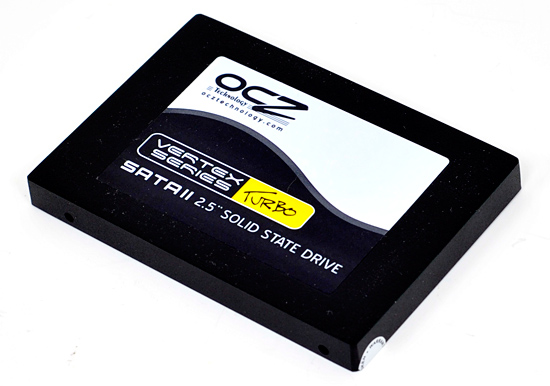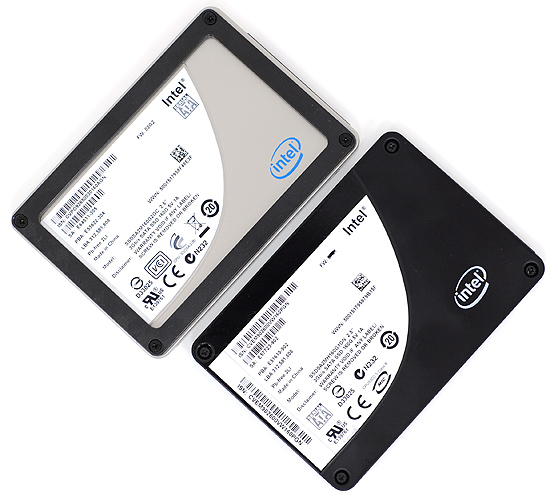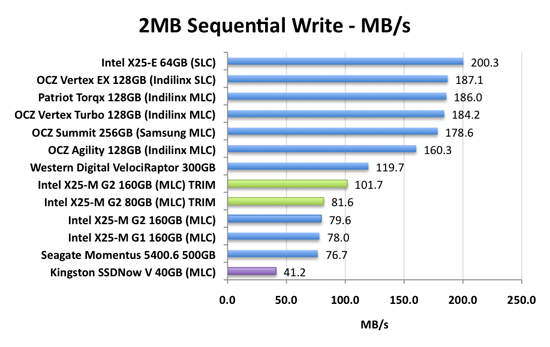The SSD Improv: Intel & Indilinx get TRIM, Kingston Brings Intel Down to $115
by Anand Lal Shimpi on November 17, 2009 7:00 PM EST- Posted in
- Storage
Update 2: Intel has given us an updated timeframe on a fixed version of its TRIM firmware. Intel will release the new firmware by the end of November 2009. More info here.
Update: Some users have had issues with Intel's TRIM firmware bricking their drives, Intel has since pulled the firmware while they figure out what's going on. If you've downloaded it but haven't updated, do so at your own risk. While we haven't had any issues on the three drives we've updated here others have had problems. We'll keep you posted. Intel's official statement is below:
“Yes, we have been contacted by users with issues with the firmware upgrade and are investigating. We take all sightings and issues seriously and are working toward resolution. We have temporarily taken down the firmware link while we investigate.”
Welcome to the anti-climax. After a year of talking about it, Windows 7 and TRIM are here. How does it feel to be a TRIMionaire?

Indilinx, as usual, was first. After a couple of false starts, the two tier 1 Indilinx partners (SuperTalent and OCZ) enabled TRIM on their Barefoot SSDs (OCZ Vertex, SuperTalent UltraDrive). OCZ calls its TRIM firmware 1.40 while SuperTalent calls it 1819. Update:As many of you have correctly pointed out, Crucial also has an 1819 update available for its SSDs. You can get the firmware for your drive from the links here:
| TRIM Firmware Download | |
| Crucial | M225 1819 |
| SuperTalent | UltraDrive GX 1819 |
| OCZ | Vertex /Agility 1.40 |
Intel held off to align with the release of Windows 7. Last week Windows 7 officially went on sale, and today Intel is delivering on its promise: this bootable iso will enable TRIM on X25-M G2 drives.

Only the X25-M G2 gets TRIM, the G1 (right) is left in the dust. The G1 is more resilient than the G2 when it comes to performance degradation over time since it doesn't have TRIM.
Alongside TRIM there’s one more surprise. If you own a 160GB X25-M G2, Intel boosted sequential write speeds from 80MB/s to 100MB/s:

The 80GB drives remain unchanged unfortunately. Intel still won’t tell us why write speeds are so low to begin with.
What TRIM Does
Before we get much further, and without diving into a complete rehash of how SSDs work (which I’ve done here, here and here again), I want to do a quick refresher on TRIM.
SSDs are made up of millions of NAND flash cells. They can be written to in groups called pages (generally 4KB in size) but can only be erased in larger groups called blocks (generally 128 pages or 512KB). These stipulations are partially the source of many SSD performance issues.
The whole ordeal gets more complicated when you realize that an SSD has no way of knowing when a file is deleted. Until an address gets used again, the SSD has to keep track of every last bit of data that’s written to it. The ATA-TRIM instruction tilts the balance in favor of the SSD.
In a supported OS (e.g. Windows 7), whenever you permanently delete a file or format your drive, the addresses that are erased are sent along with the TRIM command to the SSD’s controller. The TRIM instruction tells the SSD that those locations don’t contain valid data and that it no longer has to track them.

Simplified version of how a SSD controller works. TRIM helps the SSD clean blocks and add them to the free block pool
Again, I won’t go into great detail here but TRIM addresses a major part of the performance degradation over time issue that plague all SSDs. A TRIM enabled drive running an OS with TRIM support will stay closer to its peak performance over time.










162 Comments
View All Comments
strikeback03 - Thursday, October 29, 2009 - link
The 4k thing was a way to quantify the stuttering problem on some drives, as if he had just said "the drives stutter" but only shown objective results that look good (due to sequential write speeds), then people would have claimed he was making stuff up to be an intel fanboi as well.AnnonymousCoward - Wednesday, October 28, 2009 - link
Human-observed delay time is really all everything comes down to. 4kb performance and IOPS are interesting to look at, but they're severly inadequate. If I remember right, RAID0 tends to look awesome in benchmarks, but offers virtually zero real-world benefit.So screw the benchmarks get and out a stopwatch. Measure what matters: boot time, time to launch various applications, media encoding time, and the time to copy files. Quantified seconds are a helluva lot more meaningful than IOPS.
strikeback03 - Wednesday, October 28, 2009 - link
You mean something like this: http://www.anandtech.com/storage/showdoc.aspx?i=34...">http://www.anandtech.com/storage/showdoc.aspx?i=34...AnnonymousCoward - Wednesday, October 28, 2009 - link
Yep, something like that, but with more categories. I think this is a good set:1. Boot time
2. Time to launch applications
a) Firefox
b) Google Earth
c) Photoshop
3. Time to open huge files
a) .doc
b) .xls
c) .pdf
d) .psd
4. Game framerates
a) minimum
b) average
5. Time to copy files to & from the drive
a) 3000 200kB files
b) 200 3.5MB files
c) 1 2GB file
6. Other application-specific tasks
Imagine if we had a table of this data and all of the SSDs and a conventional HDD. That would be so much more useful than all the charts in the existing article.
buzznut - Wednesday, October 28, 2009 - link
Finally, an SSD that I can afford and makes sense to me. Anyone can afford a POS SSD drive, but this one doesn't look crippled too much. The writes I'm not too worried about, but the stuttering and performance degrading is not what I want to pay a premium for.I'm hoping by Jan-Feb (when I could afford one) that Kingston will have the trim support and upgraded firmware. Then I'll jump on it!
soltari - Thursday, December 10, 2009 - link
Just picked mine up yesterday.. Kingston 40gb bootdrive desktop kit.. Has 2CV102HA firmware .. i.e. TRim support already.. be on the lookout for it. .dont know if its all drives now or just some.http://img209.imageshack.us/img209/8616/img6915.jp...">http://img209.imageshack.us/img209/8616/img6915.jp...
http://img301.imageshack.us/img301/7214/img6920m.j...">http://img301.imageshack.us/img301/7214/img6920m.j...
box note on firmware and hdtune info screenshot..
Cavicchi - Wednesday, October 28, 2009 - link
What I read from Intel about the Optimizer suggests it is not needed in Windows 7 or not needed to actually run it. Anyone understand what Intel is saying here:"When using the latest Microsoft Windows* 7 operating system with Microsoft AHCI storage drivers the OS will contain native support to execute the Intel® SSD Optimizer on an Intel SSD without requiring any user interaction."
"Microsoft Windows* 7
Microsoft* AHCI
Native OS support (Intel® SSD Toolbox not required)"
strikeback03 - Wednesday, October 28, 2009 - link
No, that was part of the point of this article, that TRIM is supported natively in 7. It is not in earlier OSs, so they have the manual TRIM tool.drwho9437 - Wednesday, October 28, 2009 - link
Are all the Kingston SSDNOW drives X25 based in design with just different amounts of memory?Tuvok86 - Wednesday, October 28, 2009 - link
* Kingston SSDNow E Series- (Intel Controller, 50nm Intel SLC NAND, 16MB Cache)
* Kingston SSDNow M Series
- (Intel Controller, 50nm Intel MLC NAND, 16MB Cache)
* Kingston SSDNow V+ Series
- (Samsung Controller, Samsung MLC NAND, 128MB Cache)
* Kingston SSDNow V Series
40GB - (Intel Controller, 34nm Intel MLC NAND, 16MB Cache)
64/128GB - (JMicron Controller, Toshiba MLC NAND, No Cache)